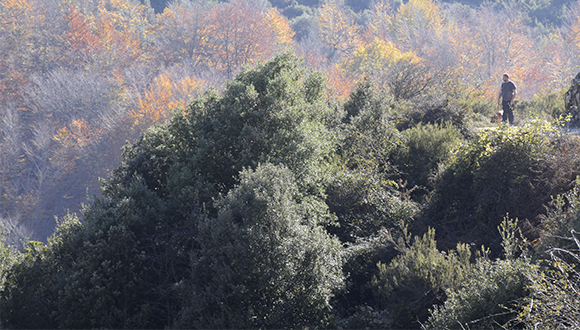How the forests of the Iberian Peninsula have changed over 25 years?
The increase in drought episodes and the lack of water in the soil have favored Mediterranean species. At the same time, conifers are losing ground because they are less adapted to droughts. These trends correspond to the period of 1987 to 2012 and have been confirmed through satellite remote sensing images.

Plant species and communities change in response to the physical characteristics of the landscape as well as climatic and human factors. A study carried out by UAB and CREAF researchers, published in Forest Ecology and Management, shows vegetation dynamics and how it has changed in three large regions of the Iberian Peninsula between 1987 and 2012. According to the study's lead author, UAB researcher Juan José Vidal Macua, "after the abandonment of many rural areas and land use change, drought and topographic variables conditioning the availability of water in the soil - including altitude, slope, soil moisture and solar radiation - have played a very important role in forest changes in recent years." The article highlights a decrease in the abundance of conifers (especially pines) and the expansion of Mediterranean broadleafs such as holm oaks, and oaks which could become dominant in many areas of the Mediterranean if the trends of increasing temperatures and diminishing water availability continue
The use of remote sensing and statistics in global change models
"The abandonment of many rural areas and land use change, drought and topographic variables conditioning the availability of water in the soil have played a very important role in forest changes in recent years."
"Identifying trends at regional and global scales and the effects of climate change on vegetation require handling large amounts of data. Up to now, the use of aerial photographs has allowed significant advancements, but satellite remote sensing is the best tool for identifying trends in vegetation dynamics on large spatial and temporal scales," says Xavier Pons, Full Professor of Geography at the UAB, also researcher at CREAF and study director. The research is a part of the ACAPI project, which studys the dynamics of land use and climate in the Iberian Peninsula over the previous 45-65 years.
To understand the trends of change in Iberian woodlands, the study analysed three regions of the peninsula. The researchers used images from the Landsat satellite, a drought database for the Iberian Peninsula (using data calucated from climate models developed by UAB professor Miquel Ninyerola), and included a large number of other environmental variables and computational statistics. Two of the study zones are from the northeastern part of peninsula: one includes much of Catalonia and the other Aragón, with a slight overlap (due to coinciding satellite orbits), and both zones reach into the Pyrenees. The third, located in Andalusia, includes Sierra Nevada and much of the Penibaetic system.

A recession of conifers replaced by broadleaves
In general, conifers are highly affected by long droughts, and it is for this reason that species such as Scots pine - a species which is better adapted to cold northern European latitudes - have been being relegated to humid areas and high mountain altitudes. The decline of this and other species has favoured certain deciduous (broadleaf) trees such as the holm oak, the kermes oak and pubescent oak. In fact, the results show that under low drought conditions, it is easier for mixed forests of deciduous and coniferous trees to become exclusively deciduous over time. However, in areas with few drought episodes, some conifers maintain their active dynamics, particularly the Aleppo Pine, which is capable of competing with the holm oak in lower-altitude Mediterranean ecosystems.
To the North, in the regions of Catalonia and Aragon, holm oak and kermes oak have been favored in those areas most affected by drought. This has occured in both mature forests and scrublands because these deciduous perennials are adapted to water deficit. In areas in Catalonia with low solar radiation, droughts have favored broadleaf deciduous trees such as the pubescent oak when it shares terrain with the Scots pine, less adapted to water deficit.

The article highlights a decrease in the abundance of conifers (especially pines) and the expansion of Mediterranean broadleafs such as holm oaks, and oaks.
Generally speaking, however, transitions to deciduous forests require water and soil moisture, and for this reason they tend to be more prevalent in the North of the Peninsula, occuring less frequently in the South where the climate is warm and dry. Deciduous trees such as oak and beech dominate the transition beginning at 1000 m altitude in mountainous areas, and especially on northern slopes where there is more moisture. In Aragon, the area surrounding the river Cinca has undergone a significant transition from coniferous to deciduous species since this river offers soils which are much more suitable for deciduous trees.
As explained by Cristina Domingo, one of the study authors and researcher at the UAB and CREAF, it is important take into account that "historical management of the territory, land abandonment and replacement of fuelwood by fossil fuels as a source of energy have also contributed to the expansion of the deciduous species." She adds, "forest change and the increasing domination of drought-resistant species in forest communities could alter the rate of carbon capture and Mediterranean forest fire regimes."
ARTICLE
Vidal-Macua J.J., Ninyerola M., Zabala A., Domingo-Marimon C., Pons X. (2017). Factors affecting forest dynamics in the Iberian Peninsula from 1987 to 2012. The role of topography and drought. Forest Ecology and Management, 406: pp 290-306. DOI: 10.1016/j.foreco.2017.10.011






